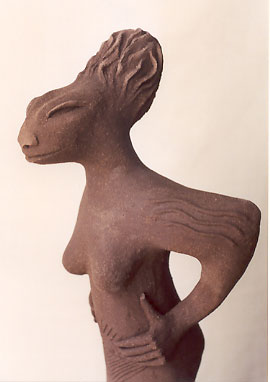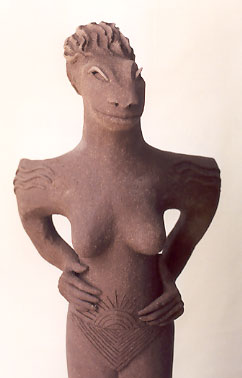inanna
goddess of life and royal power
and her alter-ego
ninhursaga
Joan Relke

inannagoddess of life and royal power
and her alter-egoninhursagaJoan Relke |
 |
Inanna is probably the most famous of all ancient goddesses. The myth about her descent to the underworld has become a metaphor for a seven-stage journey into the mystical depths of the soul which women re-enact in ritual and visualisation.
inanna's descent to the underworld
The poem recounts the mythical journey of Inanna, Queen of Heaven and Earth, to visit her sister, Ereshkigal, Queen of the Underworld. In order to reach the depths where her sister resides on her throne, Inanna must go through seven gates. At each gate she must remove an article of clothing or jewellery, so that when she arrives before her sister, she is completely naked. Undaunted by her debased position, Inanna pulls her sister off her throne, and mounts it herself. The judges of the underworld, the Anunnaki, condemn the imposter to death, and Inanna finds herself hung on a meat hook, turning green with rot.
Her handmaiden, Ninshubur, sets up the alarm on earth, and Inanna is saved by the water and food of life administered by two ministers sent by the god Enki. Ereshkigal, however, will not let Inanna go without a hostage or substitute. When Inanna returns to the world to choose her replacement, she is impressed with the grief-stricken state of many of her followers. Her husband, Dumuzi, however, has been having a grand time in her absence, partying. Inanna, outraged, picks him for her substitute, and dispatches him to Hades to rot. In another myth, Dumuzi is replaced for 6 months of the year by his sister, Geshtinanna, and between them they symbolise the agricultural life-cycle.
 |
inanna - spoilt little rich girl clay 75cm high modelled after a prehistoric figurine found at Ur, ancient city of Sumer. |
The myth of Inanna's insolent attempt to usurp her sister's throne exemplifies her character. As an imperious, petulant, demanding, but irresistible and beautiful young woman, she claims the world as her own. Several stories detail her courtship by Dumuzi, and in these stories, she is a typical teenager - preening and vain, trying to outwit her mother so she can stay out late with her boyfriend. Details of her engagement and marriage preparations indicate her wealth and status, for Dumuzi adorns her with abundant jewels taken from the "gem-revealling heap", a pile of dates, the essential food, turned into lapis lazuli and gold jewellery. But she is not only the goddess of life, love, and fecundity, she is the maker of kings.
inanna - king-maker
In some of the myths, Dumuzi is a herder god, having won the contest with the farmer god. Her choice echoes the Cain and Abel story of Genesis, in which the favoured one of God is the herder. Dumuzi is also the deified king on earth, the Shepherd of the Dark Headed People. Sumer annually brought in the New Year with a ritual marriage, hierosgamos, between the earthly king, as an incarnation of Dumuzi, the Shepherd god, and the priestess of Inanna, the incarnation of Inanna. The temples dedicated to Inanna had a special room for this annual occasion, and the priestesses of Inanna engaged in ritual "prostitution" with deserving petitioners during the year, in order to perpetuate the agricultural fertility annually renewed by the mating of Inanna and the king.
|
The figurine, 17 cm high, was found in a grave. Other similar "snake-headed" figurines have been found in graves at Ur, Uruk (Warka), home of Inanna, and Eridu. One is male and some hold a snake-like infant. The association with animals - snakes and possibly lizards - suggests a mystical or spiritual meaning, probably regarding afterlife and fecundity beliefs. Snakes in the ancient world are often associated with goddesses and fertility. |
 |
inanna and gilgamesh
All kings come to an end, and one king in particular,
Gilgamesh, did not want to suffer the same fate as his forerunners, who married
Inanna. When he was expected to marry her, he replied,
"As for making you my wife - that I will not. How would it go with me?
Your lovers have found you like a brazier which smoulders in the cold, a backdoor
which keeps out neither squall of wind nor storm, a castle which crushes the
garrison, pitch that blackens the bearer, a water-skin that chafes the carrier,
a stone which falls from the parapet, a battering-ram turned back from the enemy,
a sandal that trips the wearer. Which of your lovers did you ever love for ever?
What shepherd of yours has pleased you for all time?" (Epic of Gilgamesh).
And he goes on to recount the horrible fates of her previous lovers.
inanna's revenge
Gilgamesh spurned Inanna for another man, Enkidu, and with Enkidu he set off on many boyish adventures, which included Gilgamesh's slaying of the Bull of Heaven. Enraged at this wanton destruction, Inanna demanded that Gilgamesh pay. But since Gilgamesh was royalty, he escaped punishment, and instead, his lover/friend, Enkidu, sickened and died, leaving Gilgamesh distraught and grief-stricken. After a long soujourn in a futile search for immortality, Gilgamesh returned to his fate, and married Inanna and became king.
Inanna is a goddess who always gets what she wants - either that, or revenge. And yet who cannot love her?
|
ninhursaga the other side of the goddess clay 40cm high Also modelled on a figurine from prehistoric Mesopotamia. |
 |
Despite her eternal recurrent marriages, Inanna always returns to her virginal state without bearing a child. The mother goddess of Sumer was not Inanna, but Ninhursaga, a much more sober, responsible woman, who gave birth to all the gods and the kings, who later married Inanna.
 |
Ninhursaga's breasts are her symbol of life. She suckled all the kings, and has been said to be the mother of all Sumer's people. But she is no pushover or mere brood-cow. |
ninhursaga's wrath
Matronly and responsible, Ninhursaga was also a keen gardener, and she created a divine garden, a deathless paradise, in which she and her spouse, Enki, lived. One day, while she was away, Enki ate Ninhursaga's seven sacred plants. Ninhursaga was enraged when she returned to see Enki's swollen, sated belly. In fact, the swelling was a pregnancy, engendered by the fertility of the plants, which were actually made from semen. As a mother goddess, only Ninhursaga could save Enki's life, for only she could help him give birth to the beings ready to burst from within him. Only she had a vagina.
In her furious state, she cursed him, saying she would not "look upon him with the eye of life", and he could just die. The gods got wind of the situation, and sent an order to Ninhursaga to save the god, Enki. Enki was the god of fresh water, and without it, all would die. Ninhursaga, powerful enough but not more powerful than the high gods, grudgingly capitulated, and assisted Enki in the birth of seven goddesses. Each goddess came from a particular part of his body, and the goddess who came from his rib, they called Ti, or "life", also the same word for "rib".
In the end, everyone was happy and praised Father Enki for the birth of the seven goddesses, including the Goddess of Life, who was born from a man's rib. No doubt, Ninhursaga, replanted her trees. ("Enki and Ninhursag: A Paradise Myth")
|
|
|
3/08/09 jr